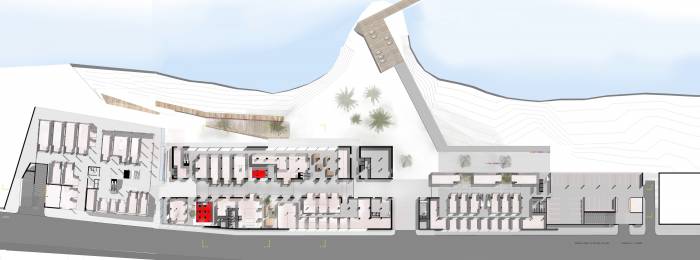












Sugar Lane
Making this urban stretch a destination, by creating a sense of cohesion in the overall program and a sense of continuity in movement throughout the 300m span across the three plots, to achieve an attractive public space that extends from the lane (plot 306) into the surrounding buildings. This was architecturally translated by developing a spine (zone reserved for pedestrian movement) that originates in the lane and creates heavy traffic around it. It was deliberately extended, generating activity around an open market as it travels within the project.
Creating a sense of place, important for place marketing, by taking advantage of the own distinctive features of the existing factory complex. In other words, understanding the identity of the existing buildings and their particular relevance, and making use of their assets in order to achieve a competitive edge in the local market. Societies are becoming more global and places are getting more alike. Thus, places need to emphasize their own special features when seeking to attract inhabitants, industries and tourism.
Integrating the notion of the ”Souk” inspired from the local culture. Although the intervention is modern and reinvented, it reinforces the identity of the local community, and at the same time expresses an international attitude, reinforcing the relation between the local and global.
Taking advantage of its proximity to the sea by introducing transverse channels that open up the lane in the direction of the sea. Those new pathways and plazas induce a complex sense of movement and address the strategic location of the project. The vertical movement was designed in the same manner to maximize the visual connection between the superimposed floors, as well as towards the Mediterranean.
The setting of the project has quite unexpected potentials. The sea and open land surrounding this urban stretch should be attractively landscaped and carefully dealt with, being a major asset to the project.
Making the history visible: industrial heritage is an important part of the identity of a place. Reuse of industrial buildings has been established as a trend over the past few decades in European countries. This tendency has almost become a new phenomenon. Sugar Lane offers an opportunity to set a precedent in Lebanon through the regeneration of the stretch, combining a new layer to the existing, and opening up innovative ways for new programmatic conversions.
